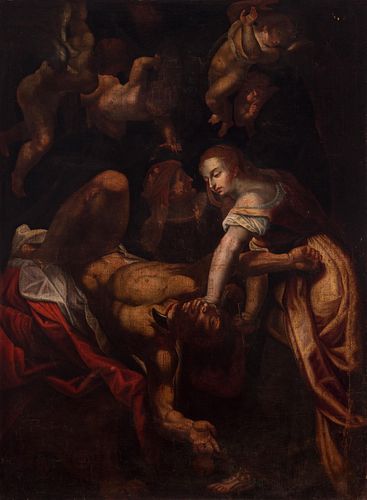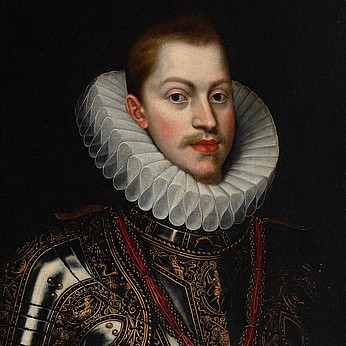Italian school; 17th century. "Judith beheading Holofernes." Oil on canvas. Old relined.
Lot 77
About Seller
Setdart Auction House
Carrer Aragó 346
Barcelona
Spain
Setdart Subastas was born in 2004 and is currently the first online art auction in Spain with solidity, prestige and reliability guaranteed by our more than 60,000 users. Setdart has a young, dynamic and enterprising team ready to successfully manage the purchase and sale of art works through custom...Read more
Estimate:
EUR€10,000 - EUR€12,000
$10,752.69 - $12,903.23
Absentee vs Live bid
Two ways to bid:
- Leave a max absentee bid and the platform will bid on your behalf up to your maximum bid during the live auction.
- Bid live during the auction and your bids will be submitted real-time to the auctioneer.
Bid Increments
| Price | Bid Increment |
|---|---|
| EUR€0 | EUR€10 |
| EUR€200 | EUR€25 |
| EUR€500 | EUR€50 |
| EUR€1,000 | EUR€100 |
| EUR€3,000 | EUR€200 |
| EUR€5,000 | EUR€500 |
| EUR€10,000 | EUR€1,000 |
| EUR€20,000 | EUR€2,000 |
| EUR€50,000 | EUR€5,000 |
About Auction
By Setdart Auction House
Nov 24, 2021
Set Reminder
2021-11-24 09:00:00
2021-11-24 09:00:00
America/New_York
Bidsquare
Bidsquare : Old Masters, Day 1
https://www.bidsquare.com/auctions/setdart-auction-house/old-masters-day-1-7873
Setdart Auction House sofia@setdart.com
Setdart Auction House sofia@setdart.com
- Lot Description
Italian school; 17th century. "Judith beheading Holofernes." Oil on canvas. Old relined. It presents faults and restorations. Measurements: 156 x 144 cm. Both for the dynamic composition of the scene, in which all the figures are in active movement, as well as for the anatomical conception of the figures, and the composition in a cross with which the work has been conceived, the piece is very reminiscent of works by the artist Peter Paul Rubens. In fact, there are several engravings of the XVII century, where Rubens' models are followed, in which this same composition is appreciated, or for example the National Museum of Warsaw, conserves a piece of very identical characteristics to the one presented, which has been attributed to the school of Rubens, and dated between 1625-1650. The painting depicts the theme of Judith beheading Holofernes, just at the most dramatic moment of the action, when he has not yet expired, but is aware of his murder. The story about Judith and Holofernes is described in the biblical book of Judith, belonging to the Old Testament. The text tells the story of a Hebrew widow (Judith), in the middle of Israel's war against the Babylonian army, erroneously called Assyrian. With beautiful features, high education and enormous piety, religious zeal and patriotic passion, Judith discovers that the invading general, Holofernes, has fallen in love with her. Accompanied by her maid, the widow descends from her walled city besieged by the foreign army and, deceiving the soldier into believing she is in love with him, manages to enter his tent. Once there, instead of yielding to his gallant claims, she intoxicates him. When Holofernes falls asleep, Judith cuts off his head, sowing confusion in the Babylonian army and thus obtaining victory for Israel. Peter Paul Rubens was a painter of the Flemish school who, however, competed on equal terms with contemporary Italian artists, and enjoyed a very important international importance, since his influence was also key in other schools, as is the case of the passage to the full baroque in Spain. Although born in Westphalia, Rubens grew up in Antwerp, where his family originated. His mother, Maria Pypelincks, was a very important character in his life. She gave him a courtly and cultural education, which included the study of Latin and Greek, as well as the Bible. It was in fact his mother who put him in contact, while still very young, with the best painters of the time. Rubens had three teachers, the first being Tobias Verhaecht, a painter of precise and meticulous technique who had traveled to Italy, and who instilled in the young painter the first artistic rudiments. It is also possible that Rubens traveled to Italy influenced by this first master. The second was Adam van Noort, a Romanist painter also oriented towards the Italian influence, with a language still Mannerist, and who must also have influenced the young man to visit Italy. Finally, his third teacher was Otto van Veen, the most outstanding and the last of them. After his training, Rubens joined the Antwerp painters' guild in 1598.
- Shipping Info
-
In-house shipping available. Please inquire at admin@setdart.com.
-
- Buyer's Premium



 EUR
EUR CAD
CAD AUD
AUD GBP
GBP MXN
MXN HKD
HKD CNY
CNY MYR
MYR SEK
SEK SGD
SGD CHF
CHF THB
THB

















